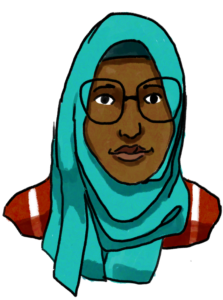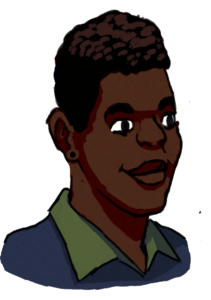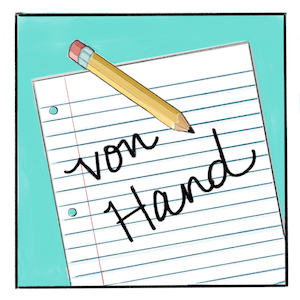In dieser Lektion
Sprechen
Umfrage
Was machen Sie gern mit Freund*innen zusammen? Nennen Sie mindestens drei Aktivitäten!
Stand up and take a poll of your fellow students. What types of activities do they typically do with their friends? Take some notes so that you can report back to your class.
Berichten
Report back on your findings about your classmates. Try a round-robin in class: report on another person’s activity with friends, and then that person reports on their findings, etc.
Beispiel: Hannah spielt gern Fußball mit ihren FreundInnen. Sie geht auch gern essen oder sieht Filme an.
Lesen

Yasmin: Mein bester Freund heißt Timo. Mit Timo gehe ich gern ins Kino oder ins Konzert, denn er weiß viel über Musik und Film. Wir diskutieren gern miteinander, besonders über Kultur (Filme, Musik, Literatur—Timo studiert Literatur an der Uni in München) aber auch über gemeinsame Freunde oder Hobbys. Timos Hobbys sind Skifahren und Fahrradfahren. Ich spiele lieber Fußball als Ski fahren, aber ich fahre manchmal Rad mit Timo. Wir sind beide gern in der Natur und wir versuchen, Fahrradwege im Wald zu finden. Manchmal machen wir zusammen ein Picknick. Am Ende eines solchen Tages sehen wir zusammen einen Film an.

Max: Ich habe viele Freunde, aber eine meiner besten Freundinnen ist Meike. Meike lernte ich durch meinen Chor kennen, weil wir beide gern singen. Wir haben auch einen ähnlichen Geschmack in der Musik: wir hören und singen die gleichen Songs gern. Wir hören oft Musik zusammen und gehen manchmal ins Konzert. Außerdem reist Meike gern und hat schon viele Länder besucht. Manchmal zeigt Meike mir Fotos von ihren vielen Reisen und ich finde ihre Fotos interessant, weil Meike so kreativ ist. Wir möchten mal zusammen nach Südafrika reisen.
Arbeit mit dem Lesen
Sprechen
Partnerarbeit: Zusammenfassen
Was macht Yasmin gern mit Timo zusammen? Was macht Max gern mit Meike zusammen? Eine Person berichtet über Yasmin und eine Person über Max.
Interview: Was machen Sie gern?
Welche Aktivitäten aus dem Lesetext machen Sie gerne mit Freund_innen? Welche nicht so gern? Sind Sie Yasmin oder Max ähnlicher?
Schreiben

Write a list of possible activities to do with friends, drawing on some of the information you gathered from your classmates as well as examples from the reading. Use as many different types of verbs as you can.
Freewrite: what do you do with your friends? Use your list and write as much as you can in 5 minutes!
Hören
Arbeit mit dem Hören
Was sagt Karl?
Was sagt Anna?
Was sagt Beate?
Kultur
Freunde und Freundinnen? FreundInnen? Freund*innen?
What’s up with all these different ways of talking about friends? Well, as you’ve already read and know, there isn’t an easy and inclusive way of talking about friends in German, because the language, like many others, has a history of gender specificity. But there are a number of strategies that individuals, organizations, and even the government are employing to make the German language more inclusive.
First, as a reminder:
der Freund, die Freunde = a (male) friend
die Freundin, die Freundinnen = a (female) friend
In the past, people tended to use the masculine plural to designate everyone. Sometimes, people would indicate both genders by using both plurals, Freunde und Freundinnen. This sometimes got shorted to Freund/innen. Then starting in the 1980s, the so-called Binnen-I was proposed as a solution: FreundInnen. The capitalized I is a way or representing that both genders, male and female, were included in the written language without having the awkward repetition of the entire word. The Binnen-I also took on a certain political message, as it was embraced by feminists and used frequently among feminist circles, even though it was not always accepted by the editors of publications.
While these strategies work to include two genders, they are not inclusive of non-binary people. So now two written forms have been developed to reflect not just two genders but a plurality of genders. Freund_innen or Freund_Innen (combined with the Binnen-I) employs the “gender gap” to draw attention to the space in between the two traditional genders. The idea is to open up that space to increase gender representation. The same is true with the other strategy, which is now gaining popularity: the Gender-Sternchen (gender asterisk). Freund*in or Freund*innen functions in the same way as the gender gap to build inclusivity of all genders.
Clearly these strategies work in written language, but are still tricky to address in the spoken language; similarly, there still aren’t great widely accepted pronouns for non-binary folks. But now that a “third sex” is recognized in Germany and Austria, the language is sure to catch up.
Note that some nouns can be replaced with nominalized verbs to create a truly gender-neutral form: die Lehrenden, meaning “those who teach” or die Lernenden, “those who learn.” Here’s another set of examples:
der Student, -en = (male) student
die Studentin, -nen = (female) student
die Student_innen, Student*innen = students (non-gender-specific)
die Studierenden = those who study
In Grenzenlos Deutsch, we try to use a variety of the strategies mentioned here so that you get used to seeing them in context and understanding their significance.
Strukturen
das Perfekt: das Partizip
In the last lesson, you learned about the past-tense form das Perfekt, or the perfect. Remember that the perfect is formed with a helping verb, haben or sein, which is conjugated to match the subject, and a participle, which goes at the end of the sentence or phrase. Here are a few examples as a reminder:
Ich habe viel mit meinen Freund*innen gespielt.
Wir sind auch oft im See geschwommen.
Both Karl and Beate talked about activities that they do with their kids and their friends. Let’s imagine that their kids are grown and are now discussing the activities that they did with their friends when they were younger.
Let’s discuss some of the examples from the exercise above. First of all, you find the participles of two weak verbs in the text: spielen and machen. Remember that participles of most weak verbs are formed by adding a “ge-” to the verb stem and a “-t” to the end: gespielt and gemacht.
You also notice several participles of strong verbs in the text. Strong verbs have participles that end in -en and many of them also have vowel changes in the participle: gegangen (from gehen), gegessen (from essen), getrunken (from trinken). How do you know what the participle of a strong verb is? You have to memorize them. This will be an ongoing process, but the vocabulary section of this lesson’s Erweiterung has a table with some common verbs for you to start memorizing.
Note that two prefix verbs are included in the text: unterhalten and herumlaufen:
- Unterhalten begins with an inseparable prefix. Unter-, be-, er-, ent-, emp-, ge-, ver-, and zer- are all examples of inseparable prefixes, as you’ve already learned. These verbs do not form their participles with “ge-“. Thus the participle of unterhalten is unterhalten (because the verb halten has the participle gehalten) the participle of bekommen is bekommen (because the participle of kommen is gekommen), and the participle of besuchen is besucht (because the participle of suchen is gesucht). In each case here, the participle of the inseparable verb does not add a “ge-” to the beginning, but the ending of the participle matches the ending of the main verb.
- Herumlaufen is a separable verb. The participle is formed by adding the “ge-” in between the separable prefix and the main verb: herumgelaufen. Other examples of this are angerufen, eingeladen, mitgekommen. In each case, the separable prefix comes before the “ge-” in the participle. Other separable prefixes include: an-, auf-, aus-, ein-, mit-, vor- and weg-.
Practice forming participles with the following activity.
Sprechen
Interview: Was haben Sie als Kind mit Freund*innen gemacht? Sprechen Sie mit einer anderen Person und bilden Sie Sätze im Perfekt.
Schreiben

Schreiben Sie 3-5 Sätze über die Fragen “Was haben Sie als Kind gemacht? Was haben Sie alleine oder mit anderen gemacht?”
Beispiel: Als Kind habe ich viel gespielt. Ich bin oft mit FreundInnen ins Kino gegangen.
das Imperfekt oder das Präteritum
You can use the perfect tense with every verb, and as you learned, the perfect tense is the tense most often used in speech to talk about past events. However, there are a few verbs that tend to be used in the simple past (das Imperfekt or das Präteritum) rather than in the perfect. Because these verbs come up frequently in speech, it is easier to use the simple past, which has only a single word. The three examples to know for now are haben, sein, and werden.
Ich habe ein Spielzeugauto gehabt = Ich hatte ein Spielzeugauto.
Ich bin sehr aktiv als Kind gewesen = Ich war sehr aktiv als Kind.
Mit 12 Jahren bin ich schüchtern geworden = Mit 12 Jahren wurde ich schüchtern.
Take a look at the tables below to see the conjugation patterns for these three verbs in the simple past.
sein
| singular | plural | ||
|---|---|---|---|
| ich | war | wir | waren |
| du | warst | ihr | wart |
| Sie | waren | Sie | waren |
| sie/es/er xier/they | war | sie | waren |
haben
| singular | plural | ||
|---|---|---|---|
| ich | hatte | wir | hatten |
| du | hattest | ihr | hattet |
| Sie | hatten | Sie | hatten |
| sie/es/er xier/they | hatte | sie | hatten |
werden
| singular | plural | ||
|---|---|---|---|
| ich | wurde | wir | wurden |
| du | wurdest | ihr | wurdet |
| Sie | wurden | Sie | wurden |
| sie/es/er xier/they | wurde | sie | wurden |
Take a closer look at these three tables. What do you notice about the endings here? Do you see a pattern?
Now practice identifying simple past forms in the following activity.